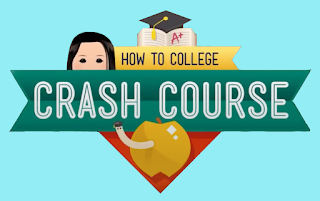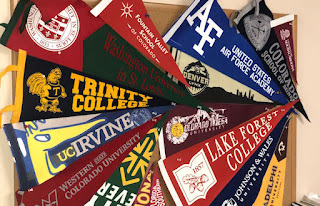There’s a new series of college advising tools in town. Crash Course, in collaboration with Arizona State University, is rolling out a series of YouTube videos on How to College. The introductory video promises the new series will discuss a wide array of college-related topics.
Crash Course is the brainchild of Hank and John Green, aka the Vlog Brothers, who have been sharing their insights online for quite a while with their followers, the Nerd Fighters. Subscribers to Crash Course number over 13 million, in part because of John’s well known teen books, most notably The Fault in Our Stars.
A quick review of any Hank and John video clearly shows these guys are smart, aware, and nerd savvy—but is this the sufficient mix needed to be effective aids in the transition to college? As the Crash Course college videos roll out, it will be crucial to evaluate their effectiveness the same way any college counseling tool is evaluated:
Beyond “Sit and Get” If a video is simply a presentation of facts and suggestions, the video is basically doing what most counselors do in classroom presentations—without the opportunity to solicit feedback. Are those opportunities available here? This is crucial.
A Curriculum, or Just Videos? It’s nice to have some ideas about college on video. It’s better when those ideas are structured as a larger whole. Add a workbook or a narrative, along with some activities, and you’re good to go. (Take a look here for an example.)
Doing Something with the Information From journal keeping to online quizzes, many videos put the students in charge of their own learning by making them do something with what they’re learning, and providing feedback on that activity in the video. Counselors know talking a subject to death is a sure turnoff; here’s hoping Crash Course has avoided that trap.
Linking Students to Counselors Many students have no college counselor or adviser to talk to at school, but many do—they just don’t connect with them. Part of this may be due to large student caseloads, but I can’t think of a counselor who isn’t going to help a student who knocks on the counselor’s door with a question. Crash Course could go a long way to connecting counselors with students if they urge students to do so in every single video (perhaps as a tag line—and devoting a video to this topic), making a crucial connection for the personalization of the advice they’re offering.
Creating a Community of Learners College-bound students benefit from talking about their understanding, and their feelings, about the college process with others. Crash Course can meet this need two ways, starting with a chat room for student subscribers. Students talking to each other about the college process always risks a sharing of misinformation, but the affective value of these rooms generally surpasses the damage that misinformation can provide, since it helps students know they aren’t alone.
The second source of processing involves counselors. If a student truly has no school-based assistance with college choice, Crash Course can meet that need by partnering with established groups of counselors and running chat rooms once or twice a month. This is the kind of work state or regional affiliates of the National Association for College Admission Counseling could take on, or independent college counselors who are members of either the Higher Education Consultants Association (HECA) or the Independent Educational Consultants Association (IECA). Working with one or more of these groups will build on the content of the Crash Course videos in meaningful and personalized ways.
Crash Course is the brainchild of Hank and John Green, aka the Vlog Brothers, who have been sharing their insights online for quite a while with their followers, the Nerd Fighters. Subscribers to Crash Course number over 13 million, in part because of John’s well known teen books, most notably The Fault in Our Stars.
A quick review of any Hank and John video clearly shows these guys are smart, aware, and nerd savvy—but is this the sufficient mix needed to be effective aids in the transition to college? As the Crash Course college videos roll out, it will be crucial to evaluate their effectiveness the same way any college counseling tool is evaluated:
Beyond “Sit and Get” If a video is simply a presentation of facts and suggestions, the video is basically doing what most counselors do in classroom presentations—without the opportunity to solicit feedback. Are those opportunities available here? This is crucial.
A Curriculum, or Just Videos? It’s nice to have some ideas about college on video. It’s better when those ideas are structured as a larger whole. Add a workbook or a narrative, along with some activities, and you’re good to go. (Take a look here for an example.)
Doing Something with the Information From journal keeping to online quizzes, many videos put the students in charge of their own learning by making them do something with what they’re learning, and providing feedback on that activity in the video. Counselors know talking a subject to death is a sure turnoff; here’s hoping Crash Course has avoided that trap.
Linking Students to Counselors Many students have no college counselor or adviser to talk to at school, but many do—they just don’t connect with them. Part of this may be due to large student caseloads, but I can’t think of a counselor who isn’t going to help a student who knocks on the counselor’s door with a question. Crash Course could go a long way to connecting counselors with students if they urge students to do so in every single video (perhaps as a tag line—and devoting a video to this topic), making a crucial connection for the personalization of the advice they’re offering.
Creating a Community of Learners College-bound students benefit from talking about their understanding, and their feelings, about the college process with others. Crash Course can meet this need two ways, starting with a chat room for student subscribers. Students talking to each other about the college process always risks a sharing of misinformation, but the affective value of these rooms generally surpasses the damage that misinformation can provide, since it helps students know they aren’t alone.
The second source of processing involves counselors. If a student truly has no school-based assistance with college choice, Crash Course can meet that need by partnering with established groups of counselors and running chat rooms once or twice a month. This is the kind of work state or regional affiliates of the National Association for College Admission Counseling could take on, or independent college counselors who are members of either the Higher Education Consultants Association (HECA) or the Independent Educational Consultants Association (IECA). Working with one or more of these groups will build on the content of the Crash Course videos in meaningful and personalized ways.




